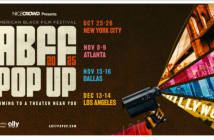By Carol Badaracco Padgett
What happens if a filmmaker needs to shoot a scene in Tasmania but the budget or logistics aren’t right to make it happen? Or what if an entire world called for in a script doesn’t exist anywhere on Earth?
These questions and hundreds like them can be answered today with an acronym plus one word: LED volume.
Case in Point
At the Savannah, Georgia, campus of the Savannah College of Art and Design (SCAD), a spaceship is gliding silently above a town in the Wild West. The chair of film and television, actor D.W. Moffett, is watching the scene in the university’s virtual production studio at the Savannah Film Studios. In the back of the studio in the darkness, a student is there too, sitting in front of a computer and controlling the scene, its backdrop created in Unreal Engine, a gaming engine developed by Epic Games that’s accessible to all filmmakers through a free download on the company’s website.
In essence, these technologies are allowing the student filmmaker to fly a spacecraft in the late 1800s: an extreme example of location on-budget.
A scenario like this is achievable today on an LED volume, which is essentially a stage surrounded by high-resolution LED panels (multiple smaller screens) that work in tandem with camera tracking and real-time rendering software to create immersive, dynamic backgrounds that adjust with camera movements.
The camera used on the virtual production stage in this example at Savannah Film Studios is a RED Komodo with a sophisticated tracking system on top. Nick Rivero, co-founder of virtual production company Meptik, with offices in Atlanta and Los Angeles, created the technological systems in play.
“Virtual production is very much a toolkit,” Rivero says. He designed the entire production stage system described above – the volume itself and all the systems that underpin it, how they all work together and the workflow students use to interact with it.
Rivero’s system represents the same cohesive, real-world platform used in professional virtual production studios everywhere. A platform where anything a filmmaker can dream up is possible to depict on-screen, virtually and realistically.
Leaps in Technology
At the Atlanta office of Crafty Apes – a company that specializes in visual effects (VFX) for film and television – VFX Supervisor Aldo Ruggiero notes this about the rise of virtual production, “LED volumes in virtual production are an evolutional part of real production. We’ve been projecting images on-screen and filming them since the car ride scenes in old movies.”
The VFX supervisor continues, “Now we can track the camera in real-time so the perspective is always correct. LED volumes change how people think about VFX. And there’s a lot more preparation.”
Sometimes, LED volumes are used similarly to early driving scenes, according to Ruggiero. He expands on that thought by saying, “In many cases, we stabilize, clean, and sometimes composite over images captured with a ‘live-action’ 360-degree camera rig. This rig uses multiple cameras pointed in different directions, and the footage is then stitched together to create a smooth, seamless moving panorama covering 180 to 360 degrees. The images are then projected on the screen.”
Ruggiero adds, “The Hogwarts Express ride at Universal Studios uses a similar approach, combining real footage with 3D animation to create an immersive experience. Behind each compartment window, a curved projection system displays a mix of live-action scenes and composited effects, evoking memorable moments from the movies.”
With computer-generated images created beforehand in Unreal Engine, Ruggiero notes, entirely new worlds can be created – in scenes depicting literally anywhere on Earth and beyond – from pre-production to post-production.
“Now, a great advantage is that we can get the reflection of the moon onto a space helmet, as opposed to having to create that [through VFX],” Ruggiero says as an example.
In addition, the immersive experiences made possible today through production with an LED volume not only gift film audiences, but actors, too. According to SCAD’s Moffett, there is a sea change between performing in front of a green screen versus a realistic setting on an LED volume.
Making movie magic more accessible
On the higher tiers of production, professional filmmakers will rent virtual production studios with LED volumes and bring in their own people to operate them, much as they do with traditional studio spaces and sound stages. For smaller productions that need virtual production technology and simply want it to work, operations like Meptik can provide a digital imaging technician and a virtual production supervisor to make the magic happen on an LED volume.
In both scenarios, virtual production studios and services are accessible and attainable, much more conveniently and far less expensively than a trip to film in Tasmania or anywhere else in the world.
But what if the script calls for something much closer to home, like the car ride scene Ruggiero mentioned?
Logistics without nightmares
“Car ride scenes are big right now, as well as action sequences in cars,” Rivero confirms. “Imagine if you had to pay to shut down downtown LA or the subways in New York. There are too many restrictions of when and how to do that, and there’s safety [to consider].”
If a production is shooting in Georgia and the scene depicts LA, virtual production technologies allow it all to be done in the Peach State and in Atlanta, in particular, where LED volumes are plentiful. It’s all about streamlining productions and creating efficiencies.
The use of Unreal Engine helps filmmakers, in this instance, as a piece of the virtual production toolkit Rivero described. “If the script calls for the car ride scene to be in downtown LA, that can be created virtually.”
Another option is for filmmakers to actually shoot the car ride in LA and then bring the footage back to a virtual production studio’s LED volume in Atlanta.
“Then we can use the LED volume to time-shift that footage and use it day to night,” Rivero says.
But every production scenario is different and efficiencies must be weighed on a case-by-case basis. “It could be much more complicated to build the [virtual production]set than to just go shoot in LA,” he adds.
When AI meets virtual production
Artificial intelligence (AI) can allow filmmakers to achieve even greater creativity, efficiency and savings.
“AI is the big one,” Rivero confirms. “It’s allowing for new concepts and new ways to create content and make screens come alive. We’re all evaluating what’s possible.” AI, for example, can enable filmmakers who use virtual production and LED volumes to create things quicker on set.
“If a director wants to look at a mountain of a certain type, for instance, you can just make that appear,” Rivero says.
But LED panels, too, are coming out with new features – they’re brighter and the computer power that makes them possible is getting better by the year.
This light-speed advancement in technology is what Ruggiero refers to as a curve jump. “A curve jump happens when something we were doing before can now be done much better – like the jump from retail stores to online shopping, as an example. But for us today it’s AI. We’ve never had anything so incredible as AI technology.”
He continues, ”A lot of the menial tasks can be done with AI. We’re jumping from the visual effects of today into the unknown.” And the same can be said for all creative arts.
“We don’t know how it will affect us,” Ruggiero reiterates. “It’s the curve jump. Where big tech leaps used to happen every 2-4 years, now it’s every year. That means a huge jump when you’re an artist utilizing virtual production technologies.”
Tasmania – along with anyplace else in this world and beyond – is becoming more attainable virtually overnight.
This article appeared in the 2025 edition of the Creative Economy Journal. See more from the Journal here.




